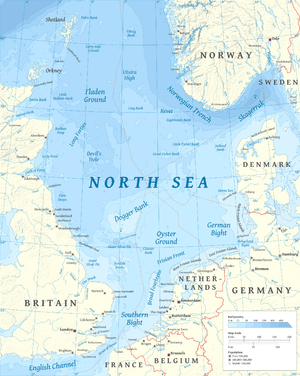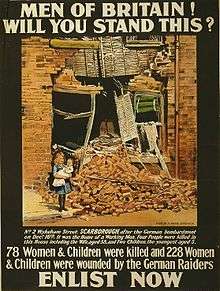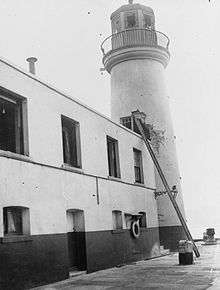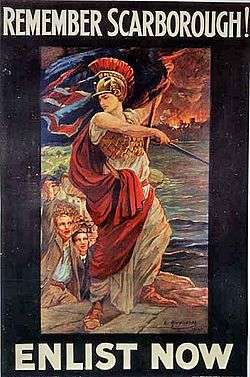Raid on Scarborough, Hartlepool and Whitby
| ||||||||||||||||||||||||||||||
The Raid on Scarborough, Hartlepool and Whitby on 16 December 1914, was an attack by the Imperial German Navy on the British seaport towns of Scarborough, Hartlepool, West Hartlepool and Whitby. The attack resulted in 137 fatalities and 592 casualties, many of whom were civilians. The attack resulted in public outrage towards the German navy for an attack against civilians and against the Royal Navy for its failure to prevent the raid.
Prelude
The German Navy had been seeking opportunities to draw out small sections of the British fleet which it could trap and destroy. Shortly before, a raid on Yarmouth had produced few results but demonstrated the potential for fast raiding into British waters. On 16 November, Rear Admiral Franz Hipper—commander of the German battlecruiser squadron—persuaded his superior, Admiral Friedrich von Ingenohl, to ask the Kaiser's permission for a raid. U-17 was sent to investigate the area near Scarborough and Hartlepool for coastal defences. The submarine reported little onshore defence, no mines within 12 mi (10 nmi; 19 km) of the shore and a steady stream of shipping. It was also believed that two British battlecruisers—which would be the fast ships sent out first to investigate any attack—had been despatched to South America, where they had taken part in the Battle of the Falkland Islands.[1]:327–328
Hipper's force included the battlecruisers SMS Seydlitz, Von der Tann, Moltke and Derfflinger, the slightly smaller armoured cruiser SMS Blücher, four light cruisers SMS Strassburg, Graudenz, Kolberg and Stralsund and 18 destroyers. Ingenohl took the 85 ships of the German High Seas Fleet to a position just east of the Dogger Bank, where they could assist if Hipper's ships came under attack from larger forces, but were still safely close to Germany as standing orders from the Kaiser instructed.[1]:328
British intelligence
The German fleet avoided any open engagement with the British fleet because it was smaller, but the difference between the two was less at this period in the war than at any other. Later, Britain improved its position by building more ships, particularly dreadnought battleships which were considered decisive in any major engagement. The British fleet had the disadvantage of maintaining continuous patrols, whereas the German one remained mainly in home port. This meant the German navy could choose a time to attack when all its ships were ready for sea, whereas some parts of the British fleet would always be in port receiving repairs or supplies, or on detached duty elsewhere. After several months of war, British ships were reaching the point where urgent repairs were needed and several had to be withdrawn from the Grand Fleet. Three battlecruisers had been sent to South America, and the brand new dreadnought HMS Audacious had been lost to a mine. HMS Thunderer, another super-dreadnought battleship, was undergoing repairs.[1]:331–332
The British had one important advantage: German ships used three main codes for which codebooks were issued to their ships. Copies of these books had been obtained from sunk or captured vessels without the Germans' knowledge. British code breakers had now reached the point where they could read German messages within a few hours of receiving them. Sufficient information had been gathered on the evening of 14 December to tell that the German battlecruiser squadron would shortly be leaving port. However, the information did not suggest that the whole German fleet might be involved.[1]:332
Admiral John Jellicoe, commanding the Grand Fleet at Scapa Flow, was ordered to despatch the First Battlecruiser Squadron of HMS Lion, Queen Mary, Tiger and New Zealand (Vice Admiral David Beatty) together with the Second Battle Squadron (Vice Admiral Sir George Warrender) containing of the modern dreadnoughts, HMS King George V, Ajax, Centurion, Orion, Monarch and Conqueror, with the First Light Cruiser Squadron of HMS Southampton, Birmingham, Falmouth and Nottingham (Commodore William Goodenough).[1]:333
Commodore Tyrwhitt at Harwich was ordered to take to sea his two light cruisers, HMS Aurora and Undaunted and 42 destroyers. Commodore Keyes was ordered to send eight submarines and his two command destroyers HMS Lurcher and Firedrake to take stations off the island of Terschelling, to catch the German ships should they turn west into the English Channel. Jellicoe protested that although such a force should be sufficient to deal with Hipper, it would not be able to face the main German fleet. The Third Cruiser Squadron from Rosyth were added to the force, with the armoured cruisers HMS Devonshire, Antrim, Argyll and Roxburgh (Rear Admiral William Pakenham).[1]:333 Jellicoe chose the point for this fleet to assemble, 25 mi (22 nmi; 40 km) south-east of the Dogger Bank. The intention was to allow the raid to take place, then ambush the German ships as they returned.[1]:333
Raid

Admiral Hipper left the Jade River at 03:00 on 15 December. During the following night, SMS S33 one of the destroyer escorts, became separated from the rest and radioed for direction. This risked giving away the presence of the ships and the destroyer was ordered to be silent. Still lost, it headed for home but on the way, sighted four British destroyers which it reported by radio. Hipper also noted radio traffic from British ships which caused concern that the British might be aware something was happening. He attributed this to possible spying by trawlers which were encountered during the day. The deteriorating weather was also causing problems. At 06:35 on 16 December, the destroyers and three light cruisers were ordered to return to Germany. Kolberg remained, as she had 100 mines on board to lay.[1]:329
The remaining ships divided, Seydlitz, Blücher and Moltke proceeded toward Hartlepool, while Derfflinger, Von der Tann and Kolberg approached Scarborough. At 08:15, Kolberg started laying mines off Flamborough Head in a line extending 10 mi (8.7 nmi; 16 km) out to sea. At 08:00, Derfflinger and Von der Tann began shelling the town. Scarborough Castle, the prominent Grand Hotel, three churches and various other properties were hit. People crowded to the railway station and the roads leading out of the town. At 09:30, the bombardment stopped and the two battlecruisers moved on to nearby Whitby, where a coastguard station was shelled, incidentally hitting Whitby Abbey and other buildings in the town.[1]:319–321
Hartlepool was a more significant target than the resort town of Scarborough. It had extensive civilian docks and factories and was defended by three BL 6 inch Mk VII naval guns on the seafront: two at Heugh Battery and one at Lighthouse Battery. The guns were manned by 11 officers and 155 local men of the Durham Royal Garrison Artillery.[2] They were warned at 04:30 of the possibility of an attack and issued live ammunition. At 07:46, they received word that large ships had been sighted and, at 08:10, a bombardment of the town began. No warning had been given to naval patrols in the area, which were meant to be always on duty and the poor weather just before the raid, meant that only four destroyers were on patrol, while two light cruisers and a submarine which might otherwise have been out, remained in Hartlepool harbour. The destroyers HMS Doon, Test, Waveney and HMS Moy were on patrol when—at 07:45— Doon saw three large vessels approaching, shortly before they opened fire. The only weapons the destroyers had capable of damaging a large vessel were torpedoes; they were out of torpedo range, so three turned away. Doon closed to 5,000 yd (4,600 m) and fired one torpedo, which missed and retreated.[1]:322–323
On shore, the batteries remained confused by the approaching ships until shells began to fall. Shells from the ships were fired at such short range that their fuses did not have time to set, so many failed to explode on impact, or ricochetted into the town, because they were travelling horizontally, rather than falling downwards. Two shore guns fired at the leading ship, while the third fired at the last, smaller, vessel. The gunners were hampered by a rising cloud of smoke and dust around them, affecting visibility. They found their shells had no effect on the armoured sides of the ships, so instead aimed at masts and rigging. The accuracy of the third gun was sufficient to oblige Blücher to move behind the lighthouse to prevent further hits. Two of her 6-inch guns were disabled, while the ship's bridge and another 8 in (200 mm) gun were damaged.[1]:323, 331
In the harbour, Captain Bruce of the light cruiser HMS Patrol attempted to get his ship to sea but the ship was struck by two 8-inch shells, forcing the captain to run her aground. The second cruiser HMS Forward had no steam in her boilers, so could not move. The submarine HMS C9 followed Patrol to sea and was forced to dive when shells started falling on them. By the time she got clear of the harbour, the enemy had gone. Commodore Roger Keyes commented afterwards that a target of three stationary cruisers was exactly what the submarine had been intended to attack.[1]:323–324
The Hartlepool attack killed 86 civilians and injured 424. Seven soldiers were killed and 14 injured. 1,150 shells were fired at the town, striking targets including the steelworks, gasworks, railways, seven churches and 300 houses. Once again people fled the town by road and attempted to do so by train. Eight German sailors were killed and 12 wounded.[1]:324–325 At 08:50, the German ships departed.
Encounter with the High Seas Fleet
The battleships and cruisers commanded by Warrender set out from Scapa Flow at 05:30 on 15 December. The bad weather meant that he could not take destroyers with him but Beatty brought seven when he departed from Cromarty at 06:00, together with the battlecruiser squadron. The two forces combined at 11:00 near Moray Firth. As the senior admiral, Warrender had overall command of the force, which sailed toward its assigned interception point at Dogger Bank.[1]:335–336
At 05:15 on 16 December, the destroyer HMS Lynx sighted an enemy ship (SMS V155). The destroyer squadron went to investigate, and a battle ensued with a force of German destroyers and cruisers. Lynx was hit, damaging a propeller. HMS Ambuscade was taking on water and had to drop out of the engagement. HMS Hardy came under heavy fire from cruiser SMS Hamburg, taking heavy damage and catching fire but managed to fire a torpedo. News of a torpedo attack was passed to Admiral Ingenohl commanding the High Seas Fleet, whose outlying destroyers were the ones involved in the fighting. The engagement broke off after a couple of hours in the dark, but at 06:03 the following morning one of the four destroyers still able to fight, HMS Shark, again came in contact with five enemy destroyers and the four attacked. The German ships withdrew, reporting another contact with an enemy force to the admiral.[1]:337–338
Ingenohl had already exceeded the strict limit of his standing orders from the Kaiser by involving the main German fleet in the operation, without informing the Kaiser.[1]:327, 328 At 05:30, mindful of the orders not to place the fleet in jeopardy and fearing he had encountered the advance guard of the British Grand Fleet, he reversed course towards Germany. Had he continued, he would shortly have engaged the four British battlecruisers and six battleships with his much larger force, which included 22 battleships. This was the opportunity that German strategy had been seeking, to even the odds in the war. The ten British capital ships would have been outnumbered and outgunned, with significant losses likely. Their loss would have equalised the power of the two navies. Churchill later defended the situation, arguing that the British ships were faster and could simply have turned about and run.[1]:339[3] Others, such as Jellicoe, felt there was a risk that an admiral such as Beatty would have insisted upon engaging the enemy once contact was established.[1]:340 Admiral Tirpitz commented "Ingenohl had the fate of Germany in his hand".[1]:339[4]
At 06:50, Shark and the destroyers again sighted an enemy ship, the cruiser SMS Roon, defended by destroyers. Captain Jones reported his sightings at 07:25, the signal being received by Warrender and also by New Zealand in Beatty's squadron but the information was not passed on to Beatty. At 07:40 Jones, attempting to close on Roon to fire torpedoes, discovered that she was accompanied by two other cruisers and was obliged to withdraw at full speed. The German ships gave chase but could not keep up and shortly returned to their fleet. Warrender changed course towards the position given by Shark, expecting Beatty to do the same. At 07:36, he attempted to confirm that Beatty had changed course but did not get a reply. At 07:55, he managed to make contact, and Beatty belatedly sent his nearest ship—New Zealand—to intercept, followed by the three light cruisers, spaced 2 mi (1.7 nmi; 3.2 km) apart, to maximise their chance of spotting the enemy, followed by the remaining battlecruisers. At 08:42, both Warrender and Beatty intercepted a message from Patrol at Scarborough advising that she was under attack by two battlecruisers. The chase of Roon, which might have led to an encounter with the main German fleet, was abandoned and the British squadron turned north to attempt to intercept Hipper.[1]:342–343
Hipper's return

At 09:30 on 16 December, Hipper's ships recombined and headed for home at maximum speed. His destroyers were now some 50 miles (43 nmi; 80 km) ahead, still moving slowly through bad weather. On inquiring where the High Seas Fleet was now stationed, he discovered that it had returned home and that his destroyers had sighted enemy ships.[1]:331
Jellicoe was now requested to move south with the Grand Fleet, which was waiting at Scapa Flow. Tyrwhitt was ordered to join Warrender with his destroyer flotilla but bad weather prevented this. Instead he joined the chase with just his four light cruisers. Keyes's submarines were to move into Heligoland Bight to intercept ships returning to Germany. Warrender and Beatty remained separated, first to avoid shallow water over the Dogger Bank but then to cut off different routes which Hipper might take, to avoid minefields laid off the Yorkshire coast. Beatty's light cruisers entered the minefield channels to search.[1]:345
At 11:25, the light cruiser Southampton sighted enemy ships ahead. The weather—which had started clear with good visibility—had now deteriorated. Southampton reported that she was engaging a German cruiser accompanied by destroyers and Birmingham went to assist. Goodenough now sighted two more cruisers, Strassburg and Graudenz but failed to report the additional ships. The two remaining British light cruisers moved off to assist but Beatty, not having been informed of the larger force, called one of them back. Due to confusion in the signalling, the first cruiser misunderstood the message flashed by searchlight and passed it on to the others. The result was that all four disengaged from the enemy and turned back to Beatty. Had Beatty appreciated the number of German ships, it is likely that he would have moved forward with all his ships, instead of recalling the one cruiser to screen his battlecruisers. The larger force suggested that major German ships would be following behind. The ships had now disappeared but were heading toward the opposite end of the minefield, where Warrender was waiting.[1]:348
At 12:15, the German cruisers and destroyers exited the southern edge of the minefield and saw battleships ahead. Stralsund flashed the recognition signal, which had been sent to her shortly before when she encountered Southampton, gaining a little time. Visibility was now poor through rain and not all the battleships had seen the enemy. Orion's captain, Frederic Charles Dreyer, trained his guns on Stralsund and requested permission of his superior, Rear Admiral Sir Robert Arbuthnot, to open fire. Arbuthnot refused until Warrender granted permission. Warrender also saw the ships and ordered Packenham to give chase with the four armoured cruisers. These were too slow and the Germans disappeared again into the mist.[1]:348
Beatty received the news that Warrender had sighted the ships and assumed that the battlecruisers would be following on behind the lighter vessels. He consequently abandoned the northern exit of the minefield and moved east and then south, attempting to position his ships to catch the German battlecruisers, should they slip past the slower British battleships. Hipper initially attempted to catch up with his cruisers and come to their aid but once they reported the presence of British battleships to the south and that they had slipped past, he turned north to avoid them. Warrender, realising that no battlecruisers had appeared in his direction, moved north but saw nothing. Kolberg, damaged in the raid and thus lagging behind the others, saw the smoke from his ships but was not herself seen. Hipper escaped.[1]:349–350, 351
Belatedly, the Admiralty intercepted signals from the High Seas Fleet at Heligoland as it returned to port and now warned the British ships that the German fleet was coming out. Jellicoe with the Grand Fleet continued to search on 17 December, attempting to engage the High Seas Fleet but failed to find it as it was safely in harbour.[1]:350
Keyes's submarines had been despatched to attempt to find returning German ships. They also failed, although one torpedo was fired at SMS Posen by HMS E11, which missed. As a last-ditch attempt to catch Hipper, the admiralty ordered Keyes to take his two destroyers and attempt to torpedo Hipper as he returned home around 02:00. Keyes himself had considered this and wanted to try. Unfortunately, the message was delayed and failed to reach him until too late.[1]:354
Aftermath

During the German warships' shelling of Old and West Hartlepool, Scarborough and Whitby, more than one thousand shells were fired, killing between 100 and 200 people and damaging about 300 houses, seven churches and five hotels.[5]
The raid had an enormous effect upon British public opinion, as a rallying cry against Germany for an attack upon civilians and in generating criticism of the Royal Navy for being unable to prevent it. The attack became part of a British propaganda campaign, 'Remember Scarborough', used on army recruitment posters; editorials in neutral America condemned it.[6]

Blame for Beatty's light cruisers' having disengaged from the enemy, initially fell upon their commander, Goodenough but the action was contrary to his past good record. Blame eventually settled on the confused signals, which had been drafted by Lieutenant Commander Ralph Seymour. Seymour remained flag officer to Beatty and continued in the same vein, making costly mistakes at both the Battle of Dogger Bank and at Jutland. A new order was drafted to captains to double check any orders to disengage if involved in a winnable battle.[1]:356
There were lucky escapes all round. The German High Seas Fleet failed to take its opportunity to engage the inferior British squadrons at Dogger Bank. The British nearly led a chase into this fleet even after it had turned away from an encounter but by chance drew back. Hipper escaped both forces set to trap him although, when his battlecruisers later met Beatty's at Jutland, it was Beatty who suffered the greater harm. Jellicoe resolved that in future, the entire Grand Fleet would be involved from the start in similar operations but the battlecruisers were moved to Rosyth to be nearer in the event more raids. The Kaiser reprimanded his admirals for the fleet's failure to capitalise upon an opportunity but made no changes to the orders restricting the fleet's use, which were largely responsible for Ingenohl's decisions.[1]:357–360
In 2010 archaeologist Bob Clarke, a local to Scarborough, offered an alternative reason for the town being shelled. He notes that at the time Scarborough was noted in maritime literature as a 'defended town' due primarily to the castle site. Furthermore, the town had three radio stations, new technology in the organisation of the Royal Naval Fleet. The shell patterns suggest that these were the targets for the raid on 16 December 1914, not the townsfolk as was widely reported at the time and perpetuated since.
See also
- Raid on Yarmouth (1914)
- Bombardment of Yarmouth and Lowestoft (1916)
References
- 1 2 3 4 5 6 7 8 9 10 11 12 13 14 15 16 17 18 19 20 21 22 23 24 25 26 27 28 29 Massie, Robert (2004). Castles of Steel: Britain, Germany, and the Winning of the Great War at Sea. London: Jonathan Cape. ISBN 0-224-04092-8.
- ↑ Litchfield, Appendix 1.
- ↑ Churchill, Winston (1923–1927). The World Crisis (4 vols). I. London: Thornton Butterworth. p. 473.
- ↑ von Tirpitz, Alfred (1919). My Memoirs (2 vols). 2. New York: Dodd, Mead. p. 285.
- ↑ Adie, Kate (2013). Fighting on the Home Front: The Legacy of Women in World War One. London: Hodder & Stoughton. p. 21. ISBN 978-1-444-75967-9.
- ↑ "It is magnificent, but it is not war". The Independent. New York. 80 (3447): 486. 28 December 1914. Retrieved 28 July 2012.
This is not warfare, this is murder.
Further reading
- Clarke, Bob (2010). Scarborough: A Result of the First Arms Race of the Twentieth Century. Stroud: Amberley Press. ISBN 1-84868-111-9.
- Marder, Arthur J. (1965). The War Years to the eve of Jutland: 1914–1916. From the Dreadnought to Scapa Flow. II. London: Oxford University Press. OCLC 865180297.
- Litchfield, Norman E. H. (1992). The Territorial Artillery 1908–1988 (Their Lineage, Uniforms and Badges). Nottingham: Sherwood Press. ISBN 0-9508205-2-0.
External links
| Wikimedia Commons has media related to Raid on Scarborough, Hartlepool and Whitby. |
- Gary Staff (translation), German Bombardment of Hartlepool, Whitby and Scarborough on 15th and 16th December, 1914. From the Kriegsmarine's Official History (Krieg zur See)
- Battles: Raid on Scarborough, Hartlepool and Whitby, 1914 FirstWorldWar.net
- Royal Navy
- The bombardment of Scarborough 1914 BBC News
